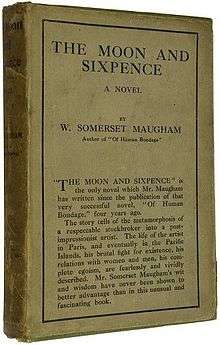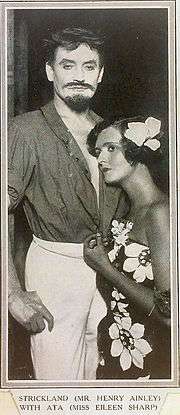The Moon and Sixpence
 Cover of the first UK edition | |
| Author | William Somerset Maugham |
|---|---|
| Country | United Kingdom |
| Language | English |
| Genre | Biographical novel |
| Publisher | William Heinemann |
Publication date | 1919 |
| Media type | Print (hardback & paperback) |
| Pages | 263 pp |
| OCLC | 22207227 |
The Moon and Sixpence is a novel by W. Somerset Maugham first published in 1919. It is told in episodic form by a first-person narrator, in a series of glimpses into the mind and soul of the central character Charles Strickland, a middle-aged English stockbroker, who abandons his wife and children abruptly to pursue his desire to become an artist. The story is in part based on the life of the painter Paul Gauguin.
Plot summary
The novel is written largely from the point of view of the narrator, a young, aspiring writer and playwright in London. Certain chapters entirely comprise accounts of events by other characters, which the narrator recalls from memory (selectively editing or elaborating on certain aspects of dialogue, particularly Strickland's, as Strickland is said by the narrator to have a very poor ability to express himself in words). The narrator first develops an acquaintance with Strickland's wife at literary parties, and later meets Strickland himself, who appears to be an unremarkable businessman with no interest in his wife's literary or artistic tastes.
Strickland is a well-off, middle-class stockbroker in London sometime in late 19th or early 20th century. Early in the novel, he leaves his wife and children and goes to Paris. (The narrator enters directly into the story at this point, when he is asked by Mrs Strickland to go to Paris and talk with her husband.) He lives a destitute but defiantly content life there as an artist (specifically a painter), lodging in run-down hotels and falling prey to both illness and hunger. Strickland, in his drive to express through his art what appears to continually possess and compel him on the inside, cares nothing for physical discomfort and is indifferent to his surroundings. He is helped and supported by a commercially successful but hackneyed Dutch painter, Dirk Stroeve (coincidentally, also an old friend of the narrator's), who recognises Strickland's genius as a painter. After helping Strickland recover from a life-threatening illness, Stroeve is repaid by having his wife, Blanche, abandon him for Strickland. Strickland later discards the wife; all he really sought from Blanche was a model to paint, not serious companionship, and it is hinted in the novel's dialogue that he indicated this to her and she took the risk anyway. Blanche then commits suicide – yet another human casualty in Strickland's single-minded pursuit of art and beauty; the first casualties being his own established life and those of his wife and children.
After the Paris episode, the story continues in Tahiti. Strickland has already died, and the narrator attempts to piece together his life there from recollections of others. He finds that Strickland had taken up a native woman, had two children by her, one of whom dies, and started painting profusely. We learn that Strickland had settled for a short while in the French port of Marseilles before traveling to Tahiti, where he lived for a few years before dying of leprosy. Strickland left behind numerous paintings, but his magnum opus, which he painted on the walls of his hut before losing his sight to leprosy, was burnt after his death by his wife per his dying orders.
Inspiration
The inspiration for this story, Gauguin, is considered to be the founder of primitivism in art. The main differences between Gauguin and Strickland are that Gauguin was French rather than English, and whilst Maugham describes the character of Strickland as being largely ignorant of his contemporaries in Modern art, as well as largely ignorant of other artists in general, Gauguin himself was well acquainted with and exhibited with the Impressionists in the 1880s and lived for a while with Van Gogh in southern France.
About the title
According to some sources, the title, the meaning of which is not explicitly revealed in the book, was taken from a review of Of Human Bondage in which the novel's protagonist, Philip Carey, is described as "so busy yearning for the moon that he never saw the sixpence at his feet."[1] According to a 1956 letter from Maugham, "If you look on the ground in search of a sixpence, you don't look up, and so miss the moon."
Adaptations

The book was made into a stage play in 1925 at the New Theatre with Henry Ainley as Strickland and Eileen Sharp as Ata and a film of the same name directed and written by Albert Lewin. Released in 1942, the film stars George Sanders as Charles Strickland.
The novel served as the basis for an opera, also titled The Moon and Sixpence, by John Gardner to a libretto by Patrick Terry; it was premiered at Sadlers Wells in 1957.[2]
Writer S Lee Pogostin adapted it for American TV in 1959. This production starred Laurence Olivier, with Hume Cronyn and Jessica Tandy in supporting roles.
In popular culture
In the opening scene of François Truffaut's cinematic adaptation of Fahrenheit 451, several firemen are preparing books for burning. In the crowd of onlookers is a little boy who picks up one of the books and thumbs through it before his father takes it from him and throws it on the pile with the rest. That book is The Moon and Sixpence.
The book was mentioned in Agatha Christie's mystery (Hercule Poirot series) novel Five Little Pigs, when Poirot asks one of the suspects (Angela Warren) if she read the book at the time the crime was committed. It is also mentioned frequently in Stephen King's 1998 novel Bag of Bones and in passing in his 2015 novel Finders Keepers.
Ray Noble's 1932 dance band hit "We've Got the Moon and Sixpence", sung by Al Bowlly, takes its name from the book and Jack Kerouac mentions the book in his 1958 novella The Subterraneans.
See also
Mario Vargas Llosa's 2003 novel The Way to Paradise is also based on Paul Gauguin's life.
Notes
External links
| Wikisource has original text related to this article: |
- Moon and Sixpence at Project Gutenberg
- The Moon and Sixpence (film) at the Internet Movie Database
-
 The Moon and Sixpence public domain audiobook at LibriVox
The Moon and Sixpence public domain audiobook at LibriVox